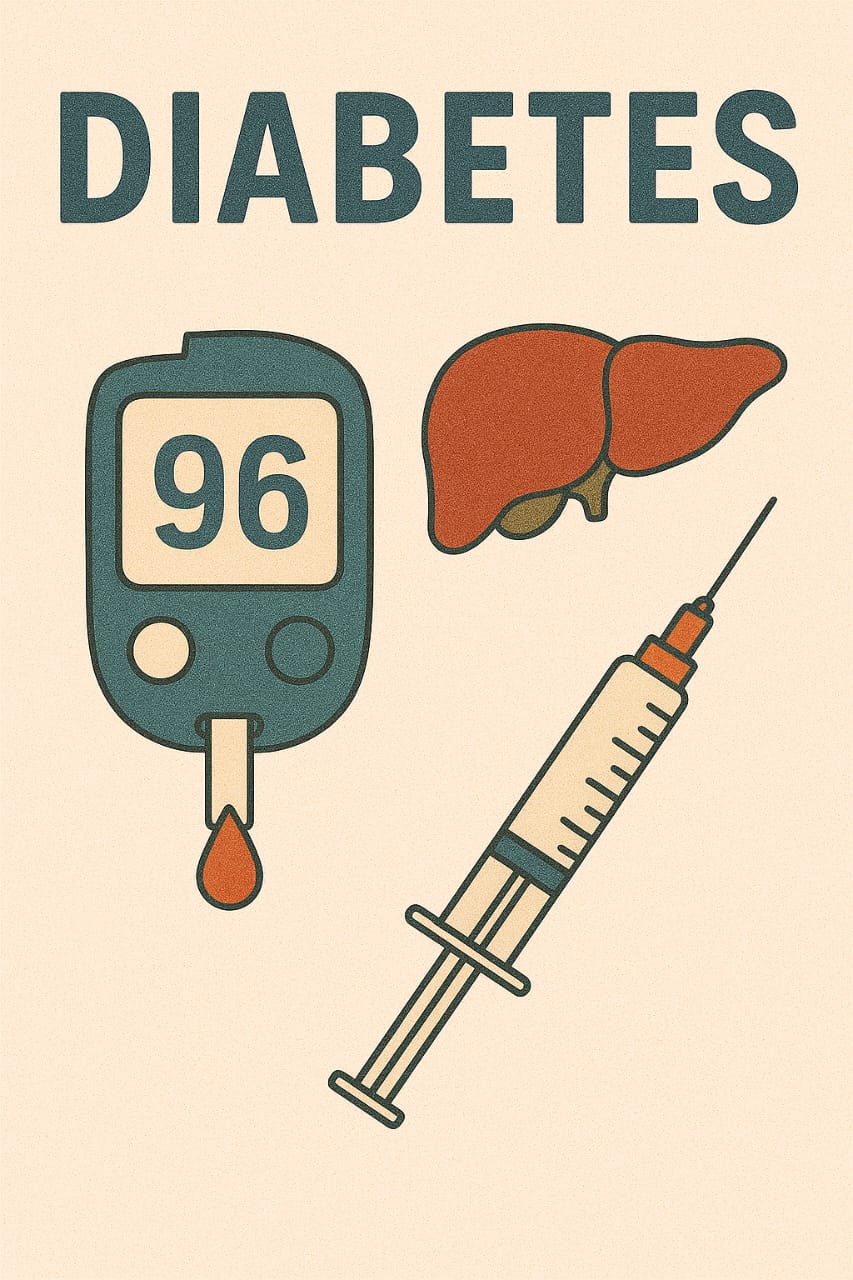Diabetes: The Complete Guide for Patients and Doctors


“For a detailed doctor-level guide, read our full reference article on Diabetes.”
Introduction
Diabetes mellitus is not a single disease—it is a family of metabolic disorders characterized by high blood sugar due to problems with insulin. It is one of the leading global health concerns, affecting millions of people across all age groups. For patients, it means a lifelong condition requiring awareness and management; for doctors, it is a clinical challenge that demands careful monitoring and individualized care.
Understanding Diabetes
There are different types of diabetes:
• Type 1 Diabetes – Autoimmune destruction of the pancreas, leading to complete insulin deficiency. Usually presents in childhood or adolescence.
• Type 2 Diabetes – Caused by insulin resistance and reduced insulin secretion. Strongly linked to obesity and lifestyle. Most common form worldwide.
• Gestational Diabetes – Appears during pregnancy, increases the risk of Type 2 later in life.
• Secondary Diabetes – Due to medications (like steroids) or other medical conditions (like Cushing’s syndrome).
Causes and Risk Factors
• Genetic factors – Family history, inherited susceptibility.
• Lifestyle – Overeating, lack of exercise, obesity, stress, smoking.
• Autoimmune triggers – Infections or immune dysfunction (mainly in Type 1).
• Other causes – Hormonal imbalances, certain medications.
How Diabetes Affects the Body (Pathophysiology)
• In Type 1, the body stops making insulin → glucose cannot enter cells → high blood sugar.
• In Type 2, insulin is produced but the body’s cells become resistant → sugar builds up in blood.
• Over time, high glucose damages blood vessels, nerves, kidneys, eyes, and the heart.
Symptoms and Warning Signs
• Increased urination (polyuria)
• Excessive thirst (polydipsia)
• Increased hunger (polyphagia)
• Unexplained weight loss
• Fatigue, irritability, blurred vision
• Frequent infections or delayed wound healing
Diagnosis
• Fasting Blood Sugar (FBS):
• Normal < 100 mg/dL
• Prediabetes: 100–125 mg/dL
• Diabetes: ≥ 126 mg/dL (on 2 occasions)
• HbA1c (3-month average):
• Normal: < 5.7%
• Prediabetes: 5.7–6.4%
• Diabetes: ≥ 6.5%
• Oral Glucose Tolerance Test (OGTT): Diabetes if ≥ 200 mg/dL at 2 hours.
Complications of Diabetes
Acute
• Diabetic Ketoacidosis (DKA): More in Type 1, life-threatening.
• Hyperosmolar Hyperglycemic State (HHS): More in Type 2, severe dehydration.
• Hypoglycemia: From excessive medication or missed meals.
Chronic
• Eyes: Retinopathy, blindness.
• Kidneys: Nephropathy, kidney failure.
• Nerves: Neuropathy, numbness, burning, foot ulcers.
• Heart & vessels: Heart attack, stroke, peripheral arterial disease.
Management
Lifestyle
• Diet: Balanced meals, avoid refined sugars, increase fiber, vegetables, lean protein.
• Exercise: At least 150 minutes of moderate activity per week.
• Weight management: Even a 5–10% weight loss improves control.
Medications
• First-line: Metformin (Type 2).
• Other oral drugs: Sulfonylureas, DPP-4 inhibitors, SGLT2 inhibitors, Thiazolidinediones.
• Insulin: Essential in Type 1, sometimes needed in Type 2.
Monitoring
• Home blood sugar checks.
• HbA1c every 3–6 months.
• Annual kidney, eye, and nerve assessments.
Special Considerations
• Pregnancy: Requires careful insulin management.
• Children: Emotional support plus medical care.
• Elderly: Simplified regimens to avoid hypoglycemia.
• Ramadan fasting: Needs doctor’s guidance for medication adjustments.
Prevention and Early Intervention
• Lifestyle modification in high-risk groups (prediabetes, obesity).
• Screening in people over 40 or with family history.
• Public health measures: promoting healthy eating, physical activity, anti-obesity campaigns.
Doctor’s Corner
For physicians, managing diabetes requires:
• Assessing patient profile before selecting therapy.
• Managing comorbidities (hypertension, dyslipidemia).
• Avoiding polypharmacy where possible.
• Educating and motivating patients.
• Referring to endocrinologists when control is difficult or complications appear.
Living Well with Diabetes
• Diabetes is not the end of life—it is a condition that can be controlled.
• Patients who stick to lifestyle changes and proper medication often live long, healthy lives.
• Mental health is important—stress, anxiety, and depression should not be ignored.
• Support from family, friends, and community is essential.
When to See the Doctor
• Sudden weight loss or gain.
• Very high or very low sugar readings.
• Chest pain, breathlessness, stroke-like symptoms.
• Persistent foot ulcers or infections.
• Blurred vision or vision loss.
Conclusion
Diabetes is a chronic but manageable condition. Patients must understand their disease, adopt healthy lifestyles, and take medicines regularly. Doctors must tailor treatment, prevent complications, and educate patients. With proper control, diabetes can be transformed from a silent killer into a manageable companion.
